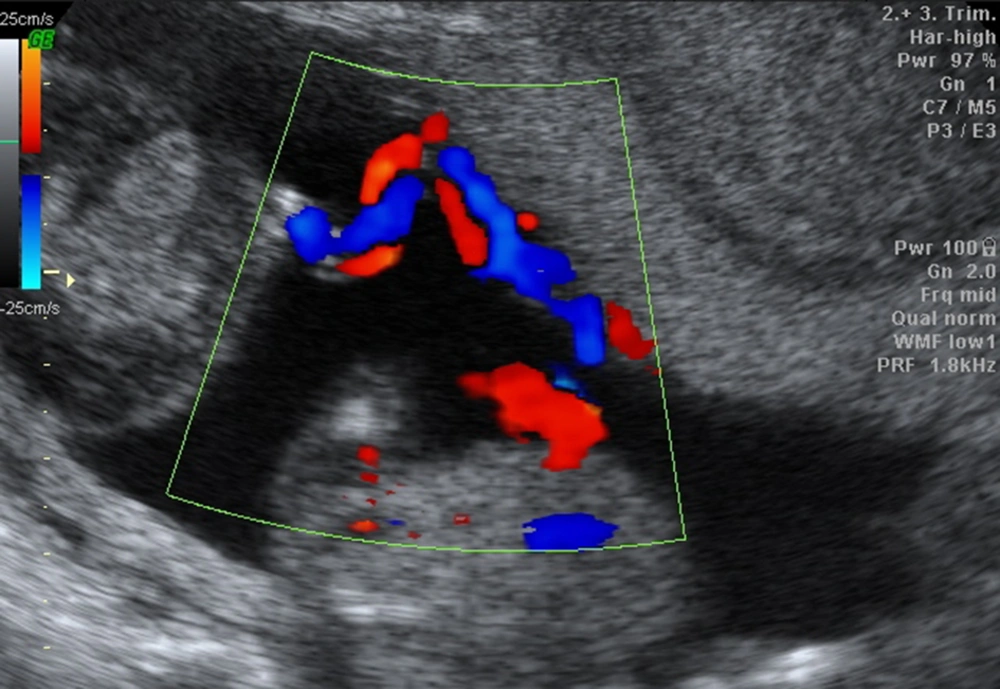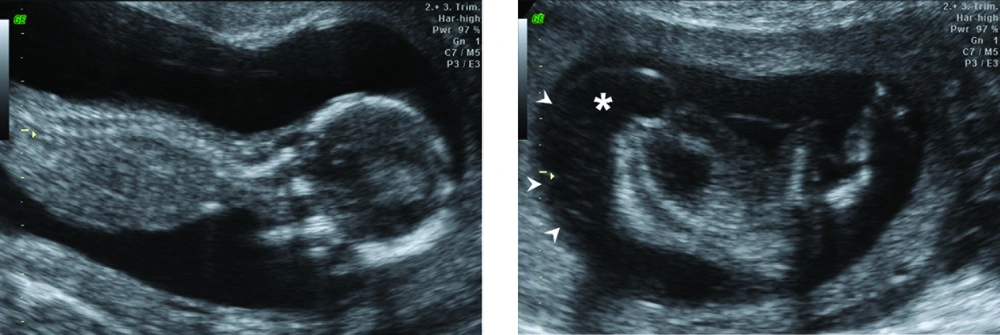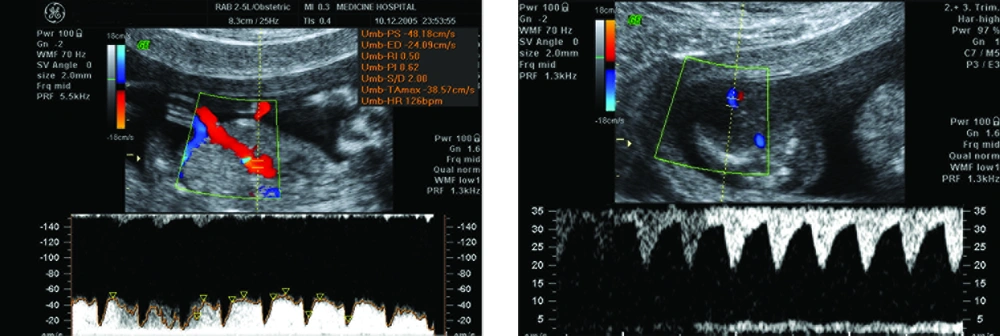1. Introduction
Twin reversed arterial perfusion (TRAP) sequence is a phenomenon with poor prognosis which is seen in 1/100 of monochorionic twin pregnancies. In TRAP sequence, there is a non-viable, acardiac fetus that has multiple anomalies and a pump fetus that feeds this fetus via vascular anastomosis in the placenta. Its incidence is 1 in 35,000 among all deliveries and one in 100 in monochorionic twin pregnancies (1). While the pump twin is anatomically normal, development is limited in only the lower part of the body in the acardiac twin of which the blood supply is provided from hypoxic blood, as in our case. Mortality is 100% in acardiac twin. Mortality of pump twin is around 50% and death is usually due to heart failure and sometimes prematurity caused by polyhydramnios (2). Herein, we present ultrasonography and Doppler findings of our TRAP case under the light of literature.
2. Case Presentation
A 21-year-old pregnant woman with 23 weeks of gestational age was referred to our clinic for advanced ultrasonography and Doppler examination with prediagnosis of fetal anomaly. Her medical history and family history were unproblematic and she did not have any systemic diseases. On obstetric ultrasonography, she had an intrauterine monochorionic monoamniotic twin pregnancy (Figure 1). Cardiac activity was rhythmic in the first fetus and fetal heart rate was 149 beat per minute and morphometric measurements were consistent with 23 weeks and 4 days, and no anomalies were detected. Fetal cardiac activity was not detected in the rudimentary thorax of the second fetus. Biparietal diameter and head circumference measurements could not be done as the fetal cranium could not be observed. The fetal abdomen was surrounded with a large hydrops ring and the lengths of the extremities were consistent with 20 weeks and 2 days (Figure 2). Umbilical circulation occurred through reversed perfusion in the recipient twin. On Doppler USG, umbilical artery systolic/diastolic (S/D) ratio increased in the pump twin and within normal ranges in the recipient twin (Figure 3). Under the light of these data, twin-twin transfusion syndrome and TRAP sequence were considered in the radiologic differential diagnosis of this complicated monochorionic–monoamniotic twin pregnancy. Chorionicity, presence of hydropic, acardiac and acephalic twin and Doppler USG findings were consistent with TRAP sequence.
3. Discussion
TRAP sequence represents a variant of conjoint twins in which chorionic circulation is shared (3). Organogenesis defect due to anastomosis in the placenta during the early embryonic period is suggested in the pathogenesis of TRAP sequence (1). In acardiac fetus placenta blood circulation between acardiac fetus and donor fetus is provided by artery-artery and vein-vein anastomosis on the placental surface (2, 4). The acardiac twin survives through these anastomoses, it uses blood which has poor oxygen, coming from cardiac twin flows reversely in arteries of the acardiac fetus and normal tissues of this fetus are partially atrophic. Atrophy is higher in the cranial parts as the caudal part uses blood predominantly (5).
Antenatal diagnosis may be made by absence of the heart on ultrasonography and revealing placental vascular anastomosis with Doppler despite presence of trunk and extremity movements in the twin that has multiple anomalies (6). Prenatal diagnosis of acardiac fetus may be made with ultrasonography at the end of the first trimester (3). Doppler studies may show pathognomonic features of reverse flow on artery-artery anastomosis (1).
Acardiac fetus is clinically divided into two types. Pseudocardiac is the presence of cardiac structures although rudimentary. Halocardia is the absence of cardiac structure development. It is widely classified into four subgroups morphologically (4, 7).
1. Acardiac acephalic: the fetus has developed pelvis and lower extremities. Head, arms and thoracic organs are absent. This is the most common type with a frequency of 60 - 75%. Our case is in this group.
2. Acardiac anceps: body and extremities have developed. Head and face are partially formed. This type consists approximately 20% of all cases.
3. Acardiac acormus: only the head of the fetus has developed. It is quite rare and consists approximately 10% of all cases.
4. Acardiac amorphous: the fetus has no identifiable organs. It is as an amorphous tissue mass and it consists approximately 5% of all cases.
Mortality is 100% for acardiac twin. Mortality of pump twin is around 50% and death may usually be due to heart failure and sometimes prematurity caused by polyhydramnios (5). Chromosomal anomalies that are reported as 9% should be excluded for management of TRAP sequence. Significance of early diagnosis is clear both for determining the therapy and also timely terminating the pregnancy which has a high mortality (2). One of the prognostic factors is the ratio of the weight of the acardiac twin to the weight of the donor twin (%). Preterm delivery is seen in 90%, polyhydramnios in 40%, and congestive heart failure in 30% when this ratio is above 70% (5). However, it is quite difficult to estimate the weight of the acardiac twin. Continuance of the growth of the acardiac twin, presence of polyhydramnios, cardiomegaly and pericardial effusion are poor prognostic factors. On color Doppler ultrasonography, low pulsatility index in the umbilical artery of the donor twin indicates poor prognosis (8).
Optimal management of acardiac twin pregnancy is controversial as it is seen rarely and with different variations. The goal of therapy is the salvage of the pump twin. Fetal and neonatal mortality rate of pump twin is high. Therefore, invasive methods toward eliminating the acardiac twin are selected (9). Discontinuation of the blood flow to the acardiac twin is the method that is applied by many authors. These methods include endoscopic umbilical cord ligation (10), sclerosis of the umbilical cord with alcohol (11), thermocoagulation of the umbilical cord and aorta under ultrasonography guidance (12), and coagulation of the umbilical cord (13, 14).
Sullivan et al. evaluated the patients with weekly serial ultrasonographies, fetal echocardiography, Doppler flow assessment, non-stress test and biophysical profile. They suggested that conservative follow-up methods have a lower mortality compared to invasive methods (15).
In conclusion, TRAP sequence is a complication that is seen in monochorionic twin pregnancies and it has a poor prognosis. Selection of the proper treatment modality by making the diagnosis with typical ultrasonography and Doppler findings is of great importance.


